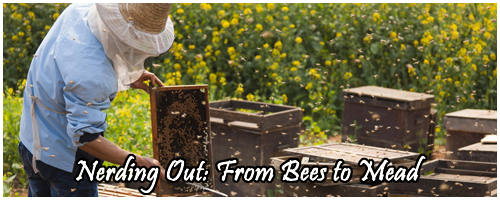Nerding Out: From Bee to Mead
Author: Former Member 065, February 2018
This time around I wanted to get into three topics that are all directly connected to each other because any time I start researching one of the three topics I end up looking at the other two. Beekeeping is nothing I’ve done or have any immediate plans to do, but that is the source for the many varieties of honey, which are used to create mead, arguably the oldest alcoholic beverage in the world.
- What are they?
Beekeeping is exactly what it sounds like and there are many hobbyists out there who will keep a hive (or a few). You can harvest your own honey and keep it or sell it, plus you’re helping keep the bee populations of the world alive. You can do this in your own backyard if you like. Beekeeping is actually one of the oldest professions and historically being a beekeeper was a prestigious job to have, before mead started losing ground to wine, beer and spirits.
Honey is a truly undervalued product, everyone goes into the supermarket and decides whether to get a liquid or solid container and goes home with basically the same honey. But in truth there are many many varieties of honey out there.
Mead, or honey wine as some may know it has a long and storied history as the drink of choice for those in the upper classes for thousands of years. It is made from honey and fermented often with the same yeasts that the winemakers use today, and the range of types of meads a person can make is as vast as beer or wine.
- How deep does the rabbit hole go?
Beekeeping: There are many different types of bees you can keep, and not all bees make honey. Some types of bees can make more honey than other and many bees survive better in one region or another. Aside from producing honey you can also get beeswax which has its own plethora of uses, including making excellent candles.
Honey: Honeys come in many varieties. Commonly when you see small batch honeys at a farmers market they’ll be wildflower honey. This is because there is no way to control what flowers the bees go to and if you aren’t creating a specific single source honey then there could be components from any number of flowers in there. Single source honeys come from when the hives are put next to a large area with a single flower, and then the honey is harvested early in the season. You get less but since most of the source is a single type of plant these honeys have very distinct flavours and colours to them. Some of these types include Acacia, Heather Honey, Orange Blossom Honey, etc. Honey can be extremely dark ambers, be distinctly red or even a pale yellow, and Acacia specifically is known for never solidifying.
Mead: Mead comes from blending different types honey together (or sometimes using just one type), adding some water and yeast and letting the yeast ferment the sugars. But it doesn’t stop there, you can add fruit and create a Melomel, grapes and make it a Pyment, beer and make it a Braggot, apples and make it a cyser, etc. Spicing mead is quite common and a well spiced mead historically could be truly valuable, given the high value of spices back in the day.
All of these can be individually done as a hobby, or together as a group. Many people like to be beekeepers, some enjoy being a connoisseur of honey and still others like to make their own mead at home, which requires maybe a couple hours of hard work and many months of patience for the mead to develop. Of these I’ve only tried the mead making myself.
- How can you too get into this?
For beekeeping there are books out there, though I’m not familiar with what ones are best, but there is almost inevitably going to be a beekeeping association somewhere in your region that can supply you with all the information you need. If you just want to taste honey then I’d recommend checking out little boutique shops in your area that may carry stuff like that, especially during the warmer seasons (if you live far enough north (or south) to have cold seasons) while the bees are active.
For mead making there’s plenty of online resources such as gotmead.com, but the best starting point is ‘The Compleat Meadmaker’. It is an incredible read that goes far more in depth on everything covered here today.
Myself I’ve made two batches of mead to date (only one type of honey) and intend to start experimenting with different yeasts in the near future, while getting some wider varieties of honey later down the road to try blending them. Other things like fruit will in my case wait for another time.
